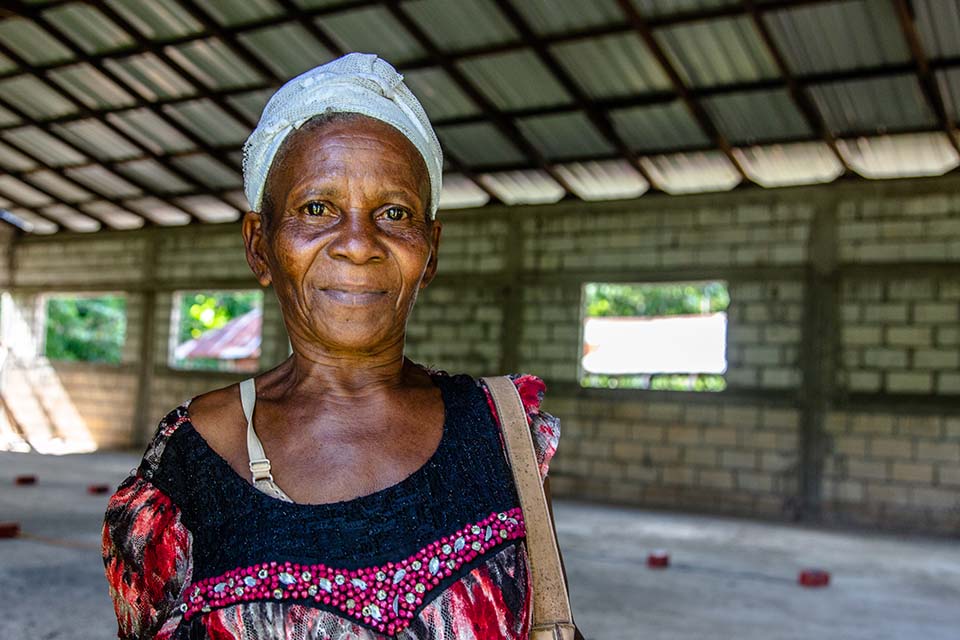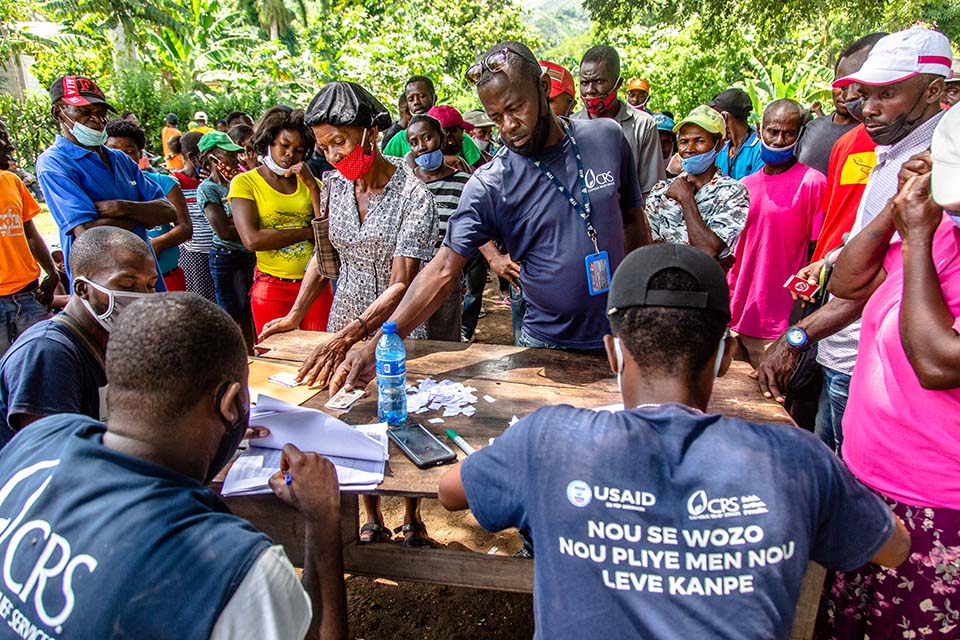Global Food Crisis—CRS has identified 25 priority countries that are affected by high levels of acute food insecurity and malnutrition due to combinations of these drivers, which are expected to continue through 2024. Areas of urgent concern include East Africa and the Sahel, as well as Central America, Southern Africa and, more recently, Gaza.


Global Emergency Update August 2022
Global Emergency Update: Haiti Earthquake Response
One year ago, a 7.2-magnitude earthquake struck Haiti about 80 miles west of Port-au-Prince, in Nippes department. Catholic Relief Services and our partners have been supporting a range of assistance to help families and communities rebuild and recover.

Aliya Jeudi receives cash assistance and other support from CRS after the 2021 earthquake.
Photo by George Harry Rouzier for CRS
Overview
On August 14, 2021, a 7.2-magnitude earthquake struck Haiti’s southern peninsula. The epicenter was located about 80 miles west of the capital, Port-au-Prince. Two days later, a tropical depression passed over the same area, exposing earthquake-affected families to additional hazards, and complicating search and rescue efforts.
More than 2,200 people lost their lives and more than 12,000 were injured. The crises destroyed more than 53,815 homes and severely damaged an additional 83,770. Tens of thousands of people were displaced throughout the area. Businesses and public infrastructure—such as hospitals, schools and bridges—suffered significant structural damage or collapse. A setback took place in January 2022, when the combination of aftershocks and flooding from heavy rains damaged or destroyed another 2,500 homes, in addition to roads and schools.
Even before the earthquake, the people of Haiti had been dealing with increasingly limited access to nutritious food and clean water due to ongoing drought, as well as escalating political and economic instability. Since the end of April 2022, the security situation has deteriorated significantly, displacing nearly 40,000 people and seriously affecting the operational environment necessary to carry out lifesaving assistance. Insecurity and road blockages have limited people's access to essential goods and services, including fuel, electricity, water and food, putting people's lives at risk.
41,500
families reached with a range of CRS and partner assistance in the first year of earthquake recovery efforts.

CRS community outreach in Nippes ensures affected communities have access to a range of assistance, including cash assistance, shelter and water and sanitation.
Photo by George Harry Rouzier for CRS
CRS Response
With your generosity, Catholic Relief Services is helping people affected by the earthquake meet their needs for immediate relief and long-term recovery. We are implementing a comprehensive, multiphase response to address the widespread impact of the earthquake. Our long history of programming in the Grand Sud departments of Sud, Nippes and Grand ’Anse means we are well positioned to respond.
During the initial rapid response, your gift enabled CRS to act quickly to help affected families meet their immediate basic needs with dignity. As we transitioned to the recovery phase, your partnership provided families with shelter, clean water, livelihoods support, assistance planning for future disasters, and services to promote emotional well-being.
CRS in Haiti
CRS has worked in Haiti since 1954, supporting diverse relief and development programs. One of the major agencies to respond to the 2010 earthquake, CRS built 10,500 shelters, provided more than 10 million meals and created employment for 11,000 people. Many experiences from 2010—such as market-based responses, participant accountability, build-back-better techniques, and community-led approaches—are applied in this response.
CRS and Church Response
The overall goal of CRS’ emergency response in Haiti is to support earthquake-affected families to meet their immediate basic needs and recover in dignity. To accomplish this, response activities are being implemented to help families:
- Live in safe transitional or permanent shelters.
- Meet their water, sanitation and hygiene needs.
- Restore livelihoods and communities.
- Improve their wellbeing.
Your Impact
With your commitment, CRS and our partners have reached more than 41,500 families with the following range of assistance.
Immediate Basic Needs:
- 9,500 families received cash assistance to buy food and other critical needs, living supplies—including tarps, bedding and hygiene items—and water purification tablets to treat water.
Safe Shelter
- More than 15,000 people whose homes were damaged received tarps and shelter repair kits.
- 1,250 displaced families received assistance relocating to safer areas, as well as grants and vouchers for food and hygiene kits.
- The most vulnerable families received assistance repairing or rebuilding their homes.
- 300 local masons were trained to complete home repairs using techniques for building back better, and five demonstration shelters were constructed to serve as training sites.
Water, Sanitation and Hygiene
- 25,000 families received clean water.
- Six temporary solar-powered water treatment systems were established in collaboration with Water Mission International.
- Three temporary systems were converted into permanent ones, in collaboration with the National Directorate of Drinking Water and Sanitation.
- Seven existing water systems are being rehabilitated.
- Community water-user committees were formed and trained to manage the water systems.
- More than 2,000 families were trained on best hygiene practices through home visits. Hygiene promotion officers also tested household water quality and distributed water purification tablets.
Livelihoods and Communities
- Six farmer field schools were established so that farmers can come together to learn improved farming practices.
- Schools were equipped with agricultural tools, including picks, hoes and machetes. Workshops on best practices for maintaining plots of land and preparing biopesticides were also conducted.
- 105 people received training on community led disaster risk management.
- Five trainings in Cavaillon, Arnaud, Plaisance, Camp Perrin and Maniche were facilitated by CRS to help community members create action plans to reduce risks.
- Five action plans were created and CRS will support communities in implementing at least one of their priority disaster riskreduction activities.
Emotional Support
- 2,400 people received training on the signs of mental distress and where to seek mental health care services offered by CRS.
- 28,391 people were reached through information campaigns on mental health and post-traumatic stress.
- 128 community leaders and health workers received training in psychological first aid.
Download & Print Global Emergency Update English Global Emergency Update
Recent Global Emergency Updates
February 2024
Ukraine War: Two Years of Emergency Relief and Recovery—In February of 2022, Russia invaded Ukraine, causing massive destruction and loss, separating families and uprooting millions of people from their homes. Over the past two years, Catholic Relief Services has worked with Caritas and other partners across Ukraine and the region to provide a range of support to meet people’s urgent needs for food, shelter, living supplies, medical care and counseling.
January 2024
Emergency Response in the Holy Land—Catholic Relief Services and our partners are responding to immediate needs of families facing hunger and displacement in the Holy Land.

